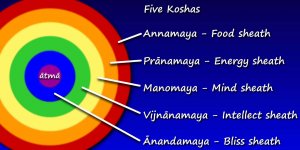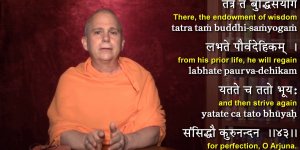| TV Channels / Documentaries |
Reincarnation
Who is it that Travels? Atma, Jiva, or the Subtle body?
A video presentation by Swami Tadatmananda Saraswati, Arsha Bodha Center, United States
(Tapescript) Welcome. I’d like to share with you some observations about the Bhagavad Gita.
I hope these insights will help you apply the profound teachings of the Gita more effectively in your life.
Towards the beginning of the Bhagavad Gita’s second chapter, just after Sri Krishna begins his upadesha, his spiritual instruction to Arjuna, he discusses reincarnation in verse 13,
Just as the embodied being, dehi, undergoes kaumaram, childhood, yauvanam, youth, and jara, old age, in the same way, dehantara, another body, praptih, will be acquired by him. tatra, in this matter, dhirah, a wise person, na muhyati, is not confused.
The indwelling being remains unchanged while the body that it inhabits grows, ages, and eventually dies.
After the body dies, the indwelling being gets associated with another body, the particular body destined by the laws of karma.
But, what exactly is that indwelling being that is said to leave one body and acquire another? What is that transmigrating entity? Who is it that gets reborn?
In this verse, Sri Krishna uses the word dehi, indwelling being, which literally means the one who inhabits a deha, body.
In this context, a lot of other words are frequently used, words like eternal soul, cosmic spirit, and life-force, also Sanskrit terms like atma, jivatma, purusha, and so on. This proliferation of words can add confusion to a topic that’s already difficult.
And to make matters worse, each of those words has various meanings and interpretations.
For example, the expression, cosmic spirit, is likely to mean different things to different people. And, if you look up the word atma in a proper Sanskrit dictionary, you’ll find more than a dozen meanings.
So, if we want know who and what this indwelling being is - without any kind of confusion, - we’ll need to be careful and precise about the words we use.
We’ll also need proper guidance for exploring this topic, and that guidance can be found in our Vedic scriptures, where the wisdom of the ancient rishis was recorded .
Let’s start our exploration with the word atma.
To understand exactly what the rishis meant by this word, we can turn to a famous verse from the Svetasvatara Upanishad which describes atma as eko devah sarvabhuteshu gudhah.
Deva literally means, one who shines, or one who is glorious. That’s why this word is often used for god.
But here, the word deva refers to the one who shines as consciousness, the consciousness within you, the consciousness that illumines your mind and reveals your thoughts, emotions, and memories.
So, this verse says, ekah devah, there is but one shining consciousness, which is gudhah, hidden, sarvabhuteshu, in all beings.
The verse goes on to describe that atma as sarvavyapi, all-pervasive, and sarvabhutantaratma, the antaratma, or the inner self, of sarva bhuta, all beings.
Putting this all together, the Upanishad defines atma as the one, all-pervasive consciousness that is the inner-self which dwells in all beings.
Now we seem to have a problem. If atma is one, and the same atma dwells in all beings, how can it be the one who reincarnates?
In order to be the one who travels, it should be associated only with the particular body which it leaves at the time of death. It can’t be the inner-self of all beings.
And there’s another problem. If atma is all-pervasive, it’s everywhere. And if atma is everywhere, how can it travel? It’s already there.
All this goes to show that the rishis did not use the word atma to refer to the entity that leaves the body at death and travels on to a new one. They used the Sanskrit word atma to mean the one, all-pervasive consciousness that dwells in all beings.
Unfortunately, this word is subject to a lot of confusion, because in Hindi and other Indian languages, the word atma is often used to refer to that transmigrating entity instead of the one, all-pervasive consciousness.
In this presentation, we’ll stick to the meaning used by the rishis.
Now, if atma is not the transmigrating entity, then who or what is it that travels? The English word, soul, is often used in this context. We can loosely say that it’s the soul that travels.
But the word soul can also cause confusion, because each of the world’s religions have a different concept of what the soul actually is.
So, for sake of clarity, we’ll avoid that English word altogether, and use a more precise Sanskrit term instead.
The term used in Vedanta is sukshma sharira, the subtle body, which is differentiated from the sthula sharira, the physical body.
Sukshma means subtle, which describes that which is not physical, not tangible, that which can’t be seen, heard, tasted, smelled, or touched.
For example, a flower is sthula, physical, but the happiness you feel when you see a beautiful flower is sukshma.
Your brain is sthula, but your mind - your thoughts, memories, and emotions - are sukshma. Your mind is not a physical object.
Your brain weighs about 2 1/2 pounds. But how much do your thoughts, emotions and memories weigh?
They exist, but not as physical objects. They are subtle, non-physical objects, and they’re part of your subtle body, your sukshma sharira.
Your sukshma sharira inhabits your physical body and endows it with life and sentiency.
Without a sukshma sharira, your sthula sharira would be a lifeless corpse.
And just as your sthula sharira has parts like arms and legs, your sukshma sharira also has parts.
A dead body has no prana, no life force. Therefore, prana is considered part of the sukshma sharira.
A dead body can’t walk or talk. Therefore, the powers of walking and talking are considered part of the sukshma sharira.
A dead body can’t see, hear, taste, touch or smell, so the five senses are also considered part of the sukshma sharira.
Finally, a dead body can’t think, remember, or feel emotions, so these mental faculties are also part of the sukshma sharira.
All of these faculties together are said to comprise the sukshma sharira.
And, it is this sukshma sharira that leaves the physical body at the time of death and travels on to acquire a new one.
Atma doesn’t travel, the sukshma sharira does.
In chapter 15 of the Bhagavad Gita, Sri Krishna describes the suksha sharira’s travel in verse 8: Here, the sukshma sharira is referred to as Ishvara, Lord, because it is lord of the body. Like a king rules over his palace, the sukshma sharira rules over the physical body.
The sukshma sharira, according to Sri Krishna, avapnoti, pervades, shariram, the physical body.
Then at death, utkramati, it leaves the physical body, grihitva etani, taking along with it all of its parts like prana, mind and senses.
Finally, samyati, it travels on to acquire another body.
A lovely image is also given here. The sukshma sharira’s travel is like gandhan, fragrance, which is blown by vayuh, the wind, ashayat, from its source, from a flower for instance.
In this verse, Sri Krishna beautifully describes the sukshma sharira as the transmigrating entity.
Now, we’re ready to discuss the relationship between the sukshma sharira which travels and atma which doesn’t.
We can take advantage of a brilliant Vedantic metaphor, or dristanta, that is traditionally used to explain this relationship.
In this metaphor, the sun shining down on the vast landscape represents atma, the one, shining consciousness that pervades all.
The wooden bucket represents the physical body, sthula sharira, and the water in the bucket represents the sukshma sharira.
The bucket is able to reflect the sun, because it’s filled with water. That describes how a physical body has life and sentiency, because of the sukshma sharira dwelling within it.
The sukshma sharira within the body reflects the one, all-pervasive consciousness, just like water in the bucket reflects the sun.
In several buckets, you’ll see several reflections of the sun, even though there is only one sun in the sky.
In the same way, we observe that there are many conscious beings in the world, even though there is but one source of consciousness, which is atma.
The one sun is reflected in many buckets, and the one shining, all-pervasive consciousness is manifest in many conscious beings.
We can restate this with familiar Sanskrit terms and say, there is but one paramatma, one supreme or universal consciousness, whereas there are many jivatmas, many individual conscious beings.
Notice that it’s the presence of water in each bucket that allows it to reflect the sun. In the same way, it’s the presence of your sukshma sharira that allows you to enjoy sentiency and experience the world around you.
As long as your sukshma sharira continues to dwell in your physical body, you’ll continue to experience the world. And when your sukshma sharira leaves your physical body, your experience of this life will come to an end.
Now, to understand reincarnation a little better, we can extend this metaphor. Suppose one of the buckets is 85 years old. The wood is rotting and several leaks have been already been plugged up so that the bucket can continue to hold water. That’s like doctors plugging up the leaks in our bodies, so to speak, using various medical procedures to keep us alive. Eventually, the old bucket will leak so badly that it’s impossible to prevent the water from draining out. This, obviously, represents death.
When a bucket is empty, it no longer reflects the sun. There’s just an empty bucket.
In the same way, when the sukshma sharira leaves a physical body, the reflection or manifestation of consciousness comes to an end, and the body no longer enjoys sentiency. There’s just a dead body.
Now, it’s time for a riddle, like a zen koan.
Does the sun shine on an empty bucket? The answer, of course, is yes. The sun shines on an empty bucket, but the sun is no longer reflected by it.
So, if we ask, is the one, all-pervasive consciousness known as atma present in a dead body?, the answer, most certainly, is yes. Consciousness is all pervasive. How can you keep it out of a dead body?
But even though it’s present in a dead body, consciousness is no longer manifest or reflected there, due to the absence of the sukshma sharira.
Now, we can extend this metaphor even further. Suppose the water that leaked out of the 85 year old bucket is collected and poured into a new bucket, a tiny little baby bucket. Then, we’ll see a new reflection of the sun in the baby bucket.
I suppose this represents the birth of a sun, if you’ll forgive the pun.
When you see that one reflected sun has disappeared from the old bucket, and a new reflected sun has appeared in the baby bucket, you might wrongly assume that the sun has traveled from the old bucket to the new bucket, when it’s actually the water that has traveled.
In the same way, many people wrongly assume that atma travels from one body to the next, when it’s actually the sukshma sharira that travels.
In addition to the traditional metaphor we just used, there’s a clever modern metaphor that you might find helpful.
Your desktop computer has hardware and software. And so do you.
The computer’s hardware represents your sthula sharira, your physical body, and the computer’s software represents your sukshma sharira.
If you look inside your computer, you’ll see the power supply unit in a corner. In this metaphor, that power supply represents your heart.
You’ll also see a tangle of assorted wires that represent your veins, arteries, and nerves.
And you’ll find the main CPU chip hidden beneath its cooling fins. Obviously, the CPU chip represents your brain.
Inside the computer chassis, you’ll also find the hard disk, the memory unit that contains all your computer’s software. That hard disk weighs about a pound and might be able to store 20 gigabytes of software in its memory. Now, if you were to completely erase all the software from that hard disk, would it weigh less? And if you were to store more software on that hard disk, filling it up to its 20 gigabyte capacity, would it weigh more?
This metaphor accurately describes the distinction between sthula and sukshma, physical and non-physical. The hard disk is physical hardware like any part of your physical body. But the software is not physical, it is subtle, like your sukshma sharira.
Without any software, your computer would be useless. It’s the presence and function of software that makes your computer a powerful, intelligent device. In the same way, it’s the presence and function of your sukshma sharira that makes you powerful and intelligent.
Suppose your computer has been working fine, but when you try turn it on today, nothing happens; the screen remains dark. You hit control-alt-delete, or whatever, and try to reboot it, but nothing happens. What’s the problem? If your computer isn’t plugged into an electrical outlet, how can it work?
In this metaphor, electricity represents atma, the one, all-pervasive consciousness, like the sun did in the previous example. It is electricity that makes each computer work, and it is the one, all-pervasive consciousness, atma, that makes all living beings sentient.
If many computers are plugged into the same power source, it’s actually the same electricity flowing into each of the computers. In the same way, it’s the same all-pervasive atma shining within each of us, illumining our minds, revealing our thoughts, emotions, and memories, and enabling us to experience the world.
Now, we can extend this metaphor to explain reincarnation, like we extended the bucket metaphor. When you buy a brand new computer, what’s the first thing you do with your old computer? You download all the software files from your old computer, and then you upload them to your new computer. Computer geeks call this software migration; we could call it transmigration.
Just like software can be transferred or migrated from an old computer to a new one, the sukshma sharira travels from a dead body to a new one.
To complete this metaphor, suppose you erased all the software from your old computer. Then, even when it’s plugged into an electrical outlet and switched on, nothing will happen. The computer will be dead, so to speak.
In the same way, even though the one, all-pervasive consciousness continues to pervade a dead body, that body will be lifeless in the absence of a sukshma sharira.
Now, we come to the final part of this presentation. Wood eventually rots and water seeps out of old buckets. That’s the way nature works. Computers eventually grow old. They get outdated and become incompatible with newer generations of software. So an old computer must be retired just like an old bucket.
All this refers to the fact that our bodies are constantly aging and will eventually be unable to hold on to a sukshma sharira.
We know that our sukshma shariras will travel on to inhabit new bodies, but we also know that at the time of death, we lose everything. We lose our loved ones, our possessions, the activities we enjoy, everything. It seems like a terrible loss awaits us all at the end of our lives.
But, with the help of Vedanta, we can discover that we truly lose nothing at the time of death.
How is that possible?
Let’s return to the bucket metaphor. When all the water leaks out of an old bucket, it stops reflecting the sun, and this represents death.
But, how is the sun affected by that? Not at all. The sun just goes on shining as the bucket decays, as it leaks, when it’s empty, and when its water is poured into a new baby bucket. The sun remains unchanged throughout.
As we saw before, the sun represents the one, all-pervasive consciousness, atma. And, that atma is you.
With the help of the teachings of Vedanta, you can discover that you are that very consciousness.
You posses a physical body, but you’re not that body. You possess a sukshma sharira that inhabits your body, but you’re not that sukshma sharira either.
You are the consciousness that illumines your mind. You are the consciousness that experiences all your thoughts, memories, and emotions. You are sat cit ananda. You are cit, consciousness. And that consciousness is sat, real. What is truly real is unborn, unchanging, and eternal. That means, you are eternal, unchanging consciousness. And that eternal consciousness is ananda, it is full, complete, perfect, limitless.
These teachings are amongst the greatest discoveries of the ancient rishis.
Unfortunately, due to ignorance, we usually identify ourselves with our bodies and minds, more specifically, with our sthula and sukshma shariras. And this erroneous identification turns out to be the root of all suffering. The teachings of Vedanta demonstrate this clearly.
Fortunately, we can put an end to suffering by destroying that false identification. We can use the teachings of Vedanta as a guide to look within ourselves, in a process of self-inquiry.
And, that process of self-inquiry can lead to a personal, direct discovery of what the ancient rishis discovered.
That discovery is moksha, freedom, liberation. Moksha is not merely freedom from rebirth. Moksha is also freedom from ignorance, freedom from false identification, and freedom from the suffering caused by our ignorance and false identification.

Subscribe now to get unrestricted access to all resources, in all languages, throughout this web site!
Subscription Form
YOU MAY ALSO LIKE







Subscribe now to get unrestricted access to all resources, in all languages, throughout this web site!
Subscription Form